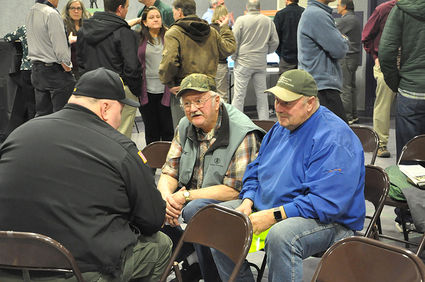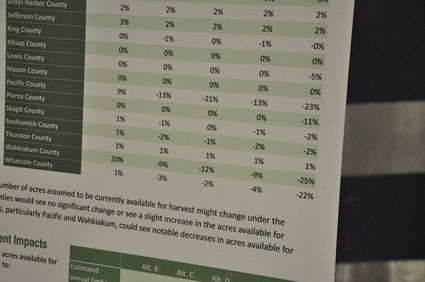Agencies gather input on harvest, murrelet
Local officials seek sustained yield for county revenue
January 26, 2017

Rick Nelson
L-r, Undersheriff Gary Howell, Grays RIver resident Al George, and Wahkiakum County Commissioner Dan Cothren discuss ramifications of proposed plans for marbled murrelets and sustainable harvests at a public meeting last Thursday.
The Washington State Department of Natural Resources (DNR) and the U.S. Fish & Wildlife Service (USFWS) hosted a meeting last Thursday to gather public input on plans for sustainable harvest and marbled murrelet management.
In November, the DNR released draft environmental impact statements for public review--the Marbled Murrelet Long-term Conservation Strategy, written jointly with USFWS, and the Sustainable Harvest Calculation for state trust lands in western Washington.
Staff of the two agencies explained the need for the two plans and different options for implementing them. The agencies have held other meetings around the state and will use the input to work on final drafts later this year.
Agency representatives commented that they have statutory responsibility to implement the two plans.
The draft impact statement for marbled murrelet management analyzes alternative approaches to long-term conservation of marbled murrelet habitat on DNR-managed lands within 55 miles of marine waters. The seabird is listed as threatened under the federal Endangered Species Act.
The draft plan has six alternatives; one is the current management plan; the other five would add 10,000 to 151,000 acres to habitat conservation areas, depending on buffers and permitted harvest practices. All apply only to land managed by the DNR.
The current management plan has locked up approximately 3,000 of Wahkiakum County's 12,000 acres of trust timber land managed by the DNR. The restrictions have resulted in a financial crisis for the county, commissioners said in a letter submitted as comment on the plan.
"The interim marbled murrelet conservation strategy that has been in place since 1997 has resulted in this financial crisis for Wahkiakum County, and none of the alternatives outlined in the Draft Environmental Impact Statement (DEIS) would rectify this," the letter says. "In fact, the DEIS states that under four of the alternatives, Wahkiakum County's harvestable acreage can be expected to be further decreased by 9 to 25 percent . . . Wahkiakum County must see a substantial increase in our timber base if we hope to stay solvent into the future."
The sustainable harvest calculation will help determine the volume of timber that DNR will harvest from 1.8 million acres of western Washington state forests during the 2015-2024 planning period. The draft impact statement documents DNR's analysis of the proposal and provides an opportunity for agencies and the public to review and provide suggestions.
Wahkiakum commissioners have also expressed concern that the harvest options won't provide adequate revenue to keep county government healthy.
Mike Buffo of the DNR commented that the agency would present a financial analysis of the different sustainable harvest plan options late this year.
Buffo also pointed out that the two plans take into account the agency's constitutional responsibilities to trust beneficiaries such as Wahkiakum County. These include the responsibility to generate revenue and other benefits for each trust, in perpetuity, and the responsibility to act prudently to reduce the risk of loss for the trusts.
Under one of the harvest plan alternatives, harvest on county trust lands would increase 20 percent; on all others, it would decrease from 9 to 25 percent.
While county officials rely on revenue from trust timber harvest to fill out the county budget, they're not optimistic about the near future, for revenue from private timber harvest is set to decline.
On Tuesday, county Treasurer Tammy Peterson reported that revenue from private timber harvest was $778,190, $52,307 lower than budgeted for 2016. She has projected $629,397 for 2017, a difference in projected revenue of $201,096.
Revenue from county trust timber harvest in 2016 was $1,095,212; only $825,000 is projected for 2017, a difference of $270,212.

Rick Nelson
This chart shows the change in harvest levels under the sustained yield alternatives; Wahkiakum County's trust lands would increase in one and decrease in all others.
To cover Current Expense Fund expenses in 2016, Peterson borrowed $1.1 million from other county funds. A payment of $927,787 from the DNR to compensate the county for encumbered trust timber lands helped knock that outstanding interfund loan balance down to $50,000 at the start of 2017.
Links to the two plans may be found on the DNR website, http://www.dnr.wa.gov. Comments on the murrelet DEIS should be submitted to the SEPA Center at sepacenter@dnr.wa.gov or SEPA Center, PO Box 47015, Olympia, WA 98504-7015. Include the file number 12-042001 on all comments. The subject line of email comments should include "SEPA File No. 12-042001."
Public comments on the sustainable harvest draft impact statement are being accepted until 5 p.m. March 9, 2017. Comments should be submitted to the SEPA Center at: sepacenter@dnr.wa.gov or SEPA Center, PO Box 47015, Olympia, WA 98504-7015. Comments should include file number 15-012901 on all comments. The subject line of email comments should include "SEPA File No. 15-012901."









Reader Comments(0)